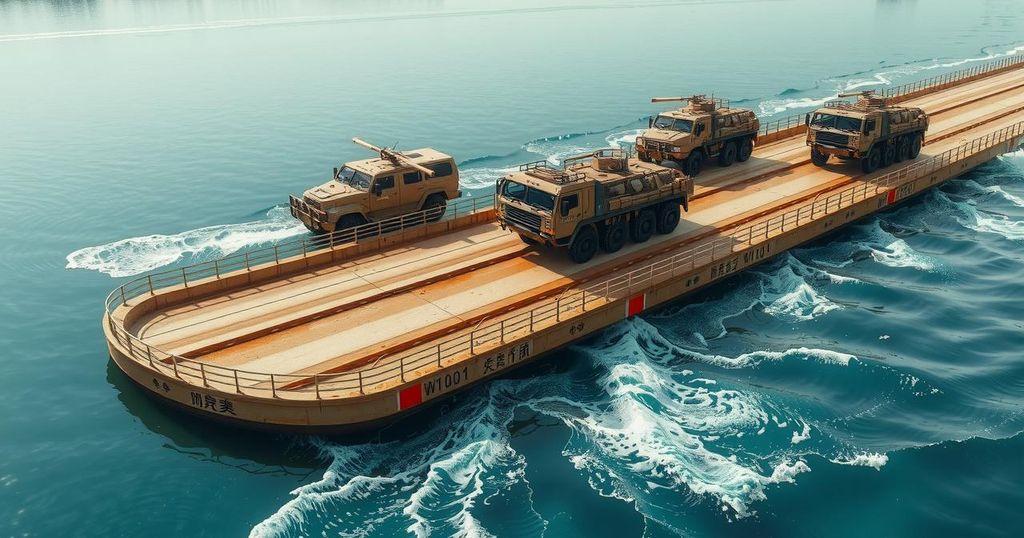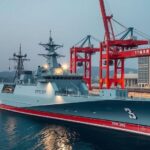The Strategic Implications of China’s New Amphibious Bridging System
Naval News examines new Chinese amphibious bridging designs, potentially vital for a PLA invasion of Taiwan. Four distinct designs, constructed by COMEC in Guangzhou, showcase features enhancing operational flexibility and efficiency. While comparisons are drawn to WWII Mulberry harbors, these modern vessels represent significant advancements, signaling the PLA’s intent to bolster its amphibious capabilities.
The article by Naval News discusses new Chinese amphibious bridging designs that may play a crucial role in a potential People’s Liberation Army (PLA) invasion of Taiwan. Recent satellite and ground imagery showcased these bridging barges, which are purportedly intended to support extensive amphibious operations targeting Taiwan. The analysis assesses the characteristics of these designs and their potential applications in military scenarios.
According to Naval News, the construction of these specialized barges was first reported in early January, with insights provided by naval analyst Tom Shugarth. The barges were built by CSSC Offshore & Marine Engineering Company (COMEC) in Guangzhou. This facility has a reputation for its naval designs, including replenishment oilers and support vessels. Notably, COMEC has diversified to include innovative marine systems, such as platforms for unmanned vehicles.
Four designs have been identified as part of the Chinese amphibious bridging system, with three suitable for operational use by the PLA. These are referred to as “jack-up barges,” self-elevating marine platforms that use legs to stabilize themselves on the seabed, allowing for safe high-load operations. Although termed barges, these vessels are self-propelled and capable of traversing significant distances, making them strategic assets in a hypothetical invasion.
Imagery revealed that three of these designs were recently spotted on Nansan Island off Zhanjiang, highlighting their potential operational scope. The exact transport method of the vessels to this location remains uncertain. During their deployment, the PLA tested connections between the barges and civilian ferries, indicating an integration of ferry operations with amphibious capabilities.
Key features of the designs include various dimensions, the number of support legs, and structural elements to accommodate cargo ships. The compact Type 2 variant is designed primarily for shallow waters and is likely to function as a connector to the shore, while the larger Type 1 and Type 3 variants enable operations in deeper water and include more advanced features, such as extended platforms and enhanced legs for stability.
The article highlights that the Chinese amphibious bridging system may facilitate rapid material disembarkation during the second phase of an amphibious landing. However, it clarifies that initial landings would likely be conducted by dedicated amphibious vessels, which would first prepare the landing site before the bridging systems are deployed. This operational strategy reflects established PLA practices in amphibious warfare.
The proposed bridging system has been suggested to serve humanitarian purposes; however, the article argues that its primary design and features align more with military operations. Existing Chinese logistics capabilities are already adequate for civilian disaster relief efforts, making the intricate designs of the bridging barges unnecessary for such purposes.
The article observes parallels between the Chinese designs and the historical Mulberry harbor utilized in World War II. While both systems aim to establish effective logistical support in amphibious operations, the modern Chinese barge designs embody advancements that enhance mobility and adaptability in demanding conditions, deviating from traditional models in significant ways.
In conclusion, the ongoing development of the Chinese amphibious bridging efforts reflects years of experimentation aimed at improving operational efficiency and flexibility for large-scale amphibious operations targeting Taiwan. The innovations presented in these new designs underscore the PLA’s commitment to enhancing its capabilities in this critical area of military strategy, addressing limitations of past systems.
In summary, the article underscores the strategic significance of the new Chinese amphibious bridging designs, which appear to be developed primarily for military applications. These designs enhance the PLA’s capabilities for rapid material disembarkation in potential operations against Taiwan. By addressing limitations seen in earlier systems, the advancements signify a proactive approach in optimizing amphibious warfare tactics. The historical context further emphasizes the ongoing evolution of maritime operations, as China seeks to refine its logistics for possible large-scale engagements.
Original Source: www.navalnews.com








Post Comment